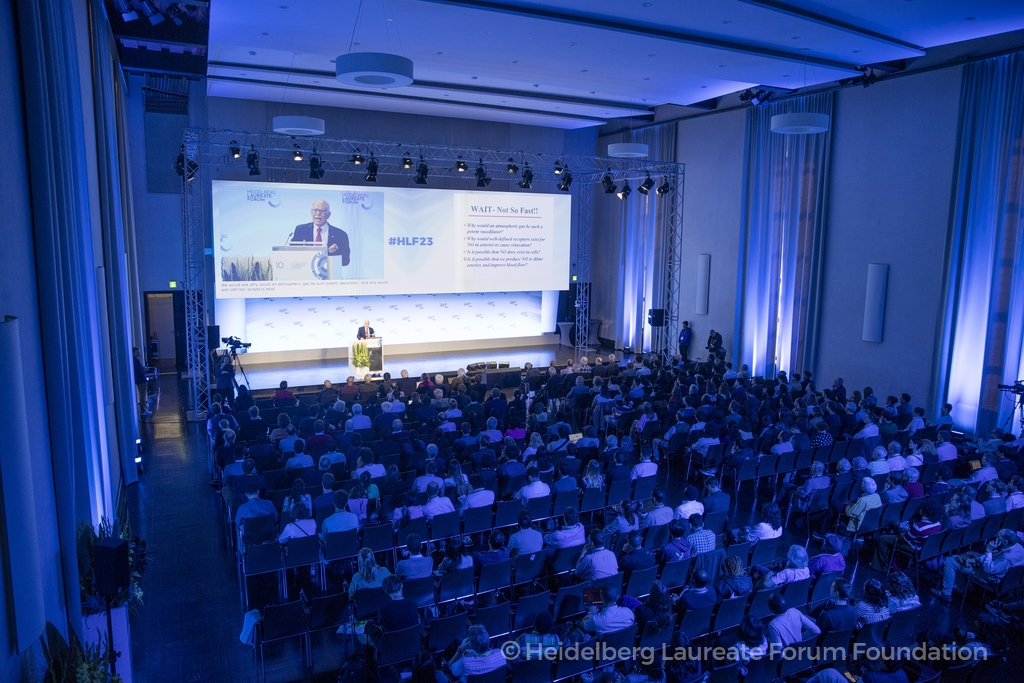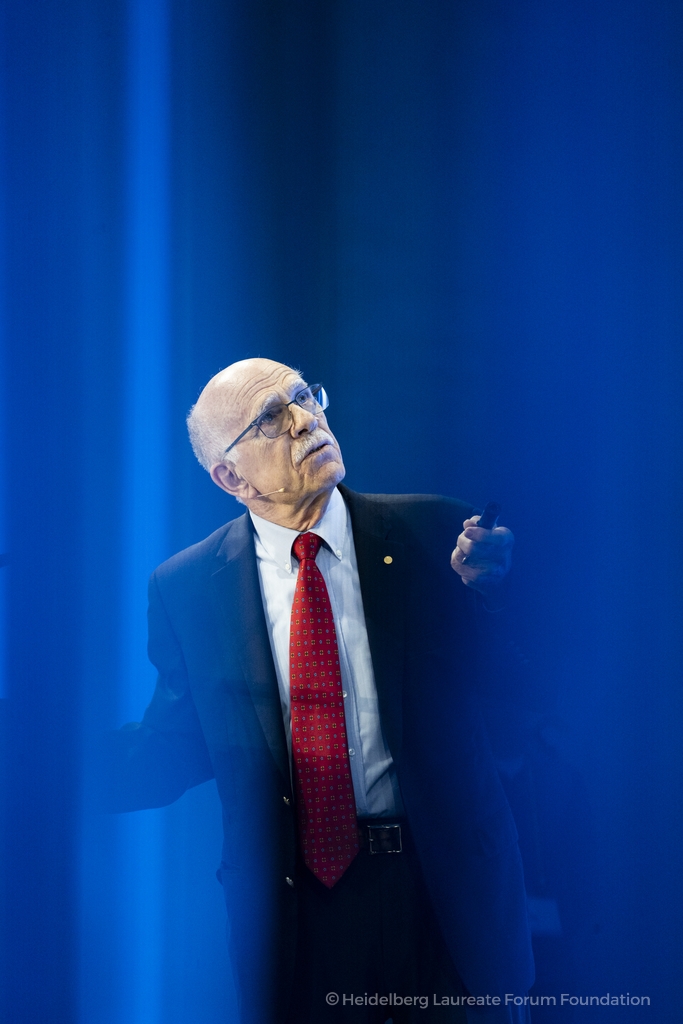Molecule of the Year 1992
Sophie Maclean
In 2013, inspired by the Lindau Nobel Laureate Meetings, the first Heidelberg Laureate Forum (HLF) was held. Fast forward ten years, and the links between the two events are as close as ever. Every year, one of the laureates of mathematics and computer science that typically attend the HLF delivers a lecture in Lindau, and in return, a Lindau Nobel laureate speaks at the Heidelberg Laureate Forum.
At the 10th HLF in September 2023, Nobel Prize recipient and pharmacologist Louis J. Ignarro held the Lindau Lecture. This year marked 25 years since he received the Nobel Prize in Physiology or Medicine for discovering the role of nitric oxide as a cardiovascular signalling module. So what is nitric oxide? And what does it do?
The Wonder Molecule
Nitric oxide is a molecule with the chemical formula NO. It’s formed by a nitrogen and an oxygen atom, joined by a double covalent bond, with one unpaired electron.
In chemistry, molecules with an unpaired electron are called “free radicals”. Radicals are highly unstable, and do not naturally exist for long. Indeed, it has been shown that the half life of NO in an aqueous solution due to the reaction with oxygen is less than 10 seconds, i.e. after 10 seconds you can expect at least half of a sample of NO to have reacted with oxygen to become NO_2.
The fact that NO so readily oxidises to NO_2 is a problem. When released into the atmosphere, NO_2 reacts with OH radicals already there to form HNO_3, also known as nitric acid. This is one form of acid rain, hence NO_2 is a major air pollutant.
It may therefore also not be surprising to learn that NO_2 can be lethal to humans, but we will discuss this more later. At this point, it should be noted that nitric oxide (NO) is not to be confused with nitrous oxide (N_2O), an anaesthetic gas.
Dr. NO
Though nitric oxide has some uses outside of biology (for example, it is sometimes used in catalytic converters), it’s safe to say that it’s most celebrated for its use is medicine and physiology.
What’s largely considered to be the most important function of NO is vasodilation i.e. the widening of blood vessels. Ignarro was put onto this idea when he spotted how samples in his lab reacted in the presence of his heavily smoking colleagues. He correctly surmised that something in the cigarettes was causing arterial tissue to relax and set about finding out which compound was responsible.
The process behind how NO causes vasodilation is fairly complicated but essentially it causes a reaction in which a phosphoryl (PO_3) group is added to several proteins in a process known as phosphorylation. This causes smooth muscle to relax, resulting in vasodilation.
Vasodilation causes increased blood flow and a drop in blood pressure, and as such, NO has many uses in a medical setting. One condition that it is used to treat is pulmonary hypertension, i.e. increased blood pressure in the arteries of the lungs. It can also improve hypoxemia (low oxygen levels) in some types of respiratory failure including acute respiratory distress syndrome. There are even trials underway investigating if NO can be used to treat COVID-19.
Another condition that can be treated with NO is angina – chest pain caused by reduced blood flow to the heart. Vasodilation lowers the pressure in arteries and also lowers left ventricular filling pressure, which has the effect of reducing cardiac workload.
A corollary of NO being an effective treatment of heart disease is that some heart diseases are caused by issues in synthesising NO. It was this that first drew Louis Ignarro’s attention to the possibility of such a molecule existing. As a child in high school, he observed how much more some people seemed to suffer from cardio-vascular disease, compared to others. He wondered whether there was a molecule that could protect from the diseases, but wasn’t until he was older that he proved this hypothesis.
Keeping it clean
Increased oxygen flow has obvious benefits in sport. which raises questions about whether or not nitric oxide could be used for doping. At the time of writing, nitric oxide is not on any WADA (World Anti-Doping Agency) prohibited list. A possible explanation for this is that it is actually very difficult to administer large quantities of NO, and the current methods are not suitable for sport.
You may recall that NO is present in cigarettes, and in the very short term there is anecdotal evidence that asthma patients find that cigarettes relieve their symptoms. However, there are many compounds aside from nitric oxide, some of which make asthma worse over time, and some of which are carcinogens. So cigarettes are not a good idea for asthma patients, athletes, or anyone else.
Nitric oxide can be inhaled but pure NO would be too concentrated by orders of magnitude. NO readily oxidises to NO2 which is lethal to humans so it needs to be administered in a hospital setting. A solution to this is to use very low concentrations of NO, which react very slowly with O2 and form negligible quantities of NO2, but caution is still advised here.
NO can also be administered via nitroglycerine, but these methods both have their issues too. Nitroglycerine is an explosive and hence must be handled with care. Even without this though, this is still a risky method. If vasodilation occurs too quickly (which can happen when nitroglycerine is given) then the patient’s blood pressure might drop too fast. This could cause the patient to pass out, and reduce blood flow to the heart and brain which has the potential to cause serious damage.
Eat Your Greens
Fear not though! There are safe ways to increase nitric oxide in the human body. Nitric oxide is naturally produced in mammals by cells so rather than artificially introducing NO to the body, it’s possible to aid the body in producing more NO.
One really simple way of increasing your NO production is breathing through your nose. This is because some of the cells producing nitric oxide are located in the nose. This is one reason why athletes are encouraged to breathe through their nose as much as possible.
Nitric oxide is produced from nitrates, which can be found in some vegetables. By eating more leafy greens, such as spinach, lettuce, cress and rocket (or arugula if you prefer), one can increase their dietary intake of nitrates. Some studies have indicated that eating vegetables rich in nitrates can be as effective at lowering blood pressure as some medications.
Another dietary change that can increase NO production is eating more foods rich in antioxidants. Anti-oxidants do what they say on the tin – they reduce oxidation. This increases the half-life of nitric oxide in the body, and so increases its concentration. Examples of anti-oxidants include vitamin C and vitamin E, hence a good source of antioxidants are plant-based foods, such as carrots, citrus fruits and blueberries. Dark chocolate also contains a wide variety of anti-oxidants, and if you’re anything like me, it also makes you very happy.
Raising the profile
Louis Ignarro was awarded the Nobel Prize in 1998, along with Robert Furchgott and Ferid Murad. Their breakthrough papers about how NO caused vasodilation were all published in the 1970s and early 1980s. So what caused the Nobel committee to award them their prizes so much later? Ignarro has a theory.
In the 1990s, Ignarro showed how nitric oxide acts as a neurotransmitter mediating the erection of the penis. It does this by causing the accumulation of a molecule known as cyclic GMP (or cGMP), which in turn causes vasodilation and increased blood flow to the penis.
This discovery got a lot of attention. It should also be noted that NO plays a similar role in the erection of the clitoris, though it’s perhaps a measure of the world that we live in that this received significantly less attention.
On 9 January 1992, the front page of the New York Times included a short article with the heading “Chemical A Factor in Male Impotence”. Newspapers all around the world ran similar features, with one newspaper in Italy even including a cartoon!
By 1998, this discovery had led to the production of a drug to treat erectile dysfunction. This drug is called sildenafil, but you’re more likely to recognise the brand name: Viagra. Viagra doesn’t itself produce NO but instead enhances its effect as a neurotransmitter. Viagra inhibits a molecule known as PDE-5, which normally breaks down cGMP. As a result, there is a noticeable increase in cGMP accumulation in response to even a small amount of NO.
Interestingly, Viagra’s ability to cause vasodilation means that it can sometimes be taken to treat pulmonary arterial hypertension. It’s even been suggested that it could be used to treat some symptoms of Reynaud’s phenomenon. You probably know someone who suffers from Reynaud’s phenomenon – sufferers experience reduced blood flow to the end of arterioles, in particular extremities such as fingers and toes, which can cause the skin to turn white and then blue.
Because Viagra works by promoting vasodilation though, care must also be taken. Those taking nitroglycerine, as mentioned before, or indeed any other medication to increase nitric oxide, risk experiencing a rapid drop in blood tension, with serious consequences.
Saying YES to NO
You’d be right if you’ve guessed – perhaps from the sheer number of applications – that Ignarro’s work on NO wasn’t plain sailing. Ignarro faced a lot of failure throughout the course of his research. It was through his conviction that he was onto something that he was able to push through and keep his enthusiasm up.
It will be clear by now how important nitric oxide is. It may therefore to surprise you that Louis Ignarro faced serious pushback. Before the work of Ignarro, Furchgott and Murad, nitric oxide had a reputation as a pollutant. Other scientists discouraged Ignarro from pursuing his work, not believing it would come to anything. Once again, it was the strength of Ignarro’s belief that his work would yield results that allowed him to not be deterred.
Science is Science
The Lindau lecture is unique in the Heidelberg Laureate Forum academic program in that it is not directly related to mathematics or computer science. Despite this, it still proves to be a great inspiration to young researchers as the experience of research has similarities across all disciplines. Ignarro’s talk demonstrated this excellently.
Louis Ignarro first began thinking about the work that led to his Nobel Prize as a child, something that many mathematicians and computer scientists will relate to. One need look no further than Andrew Wiles’ work on Fermat’s Last Theorem to see a famous example of a mathematician discovering a problem at a young age and chipping away until they’ve solved it.
Medicine, like mathematics and computer science, can also be very collaborative. Louis Ignarro won his Nobel Prize alongside two other scientists (Robert Furchgott and Ferid Murad). Similarly, a large number of maths and computer science papers have several authors. In fact, 2022 Fields medallist Hugo Duminil-Copin spoke in his HLF press conference about how every single paper that earned him his Fields Medal had multiple authors.
One final similarity that Ignarro’s work has to maths and computer science is how something designed for one application can have far-reaching consequences. Just as number theorists had no idea that their work on prime numbers would form the basis of modern cryptography, Louis Ignarro could not have predicted that his research would eventually be used to help combat a global pandemic.
These are just some of the insights that young researchers will have gained from listening to Louis Ignarro. What makes Ignarro’s work so inspiring, though, is the roadblocks he overcame along the way. Just like Ignarro, the young researchers may well have to keep going through failure and persevere in the face of others not seeing the value of their work. Here, they could learn a lot from Ignarro. In his lecture, Louis Ignarro shared a quote by Ralph Waldo Emerson: “Do not go where the path may lead, go instead where there is no path and leave a trail”. This sums up his philosophy very well, and to a room of young scientists about to start their careers, Louis Ignarro’s advice couldn’t have been better.
The post Molecule of the Year 1992 originally appeared on the HLFF SciLogs blog.


